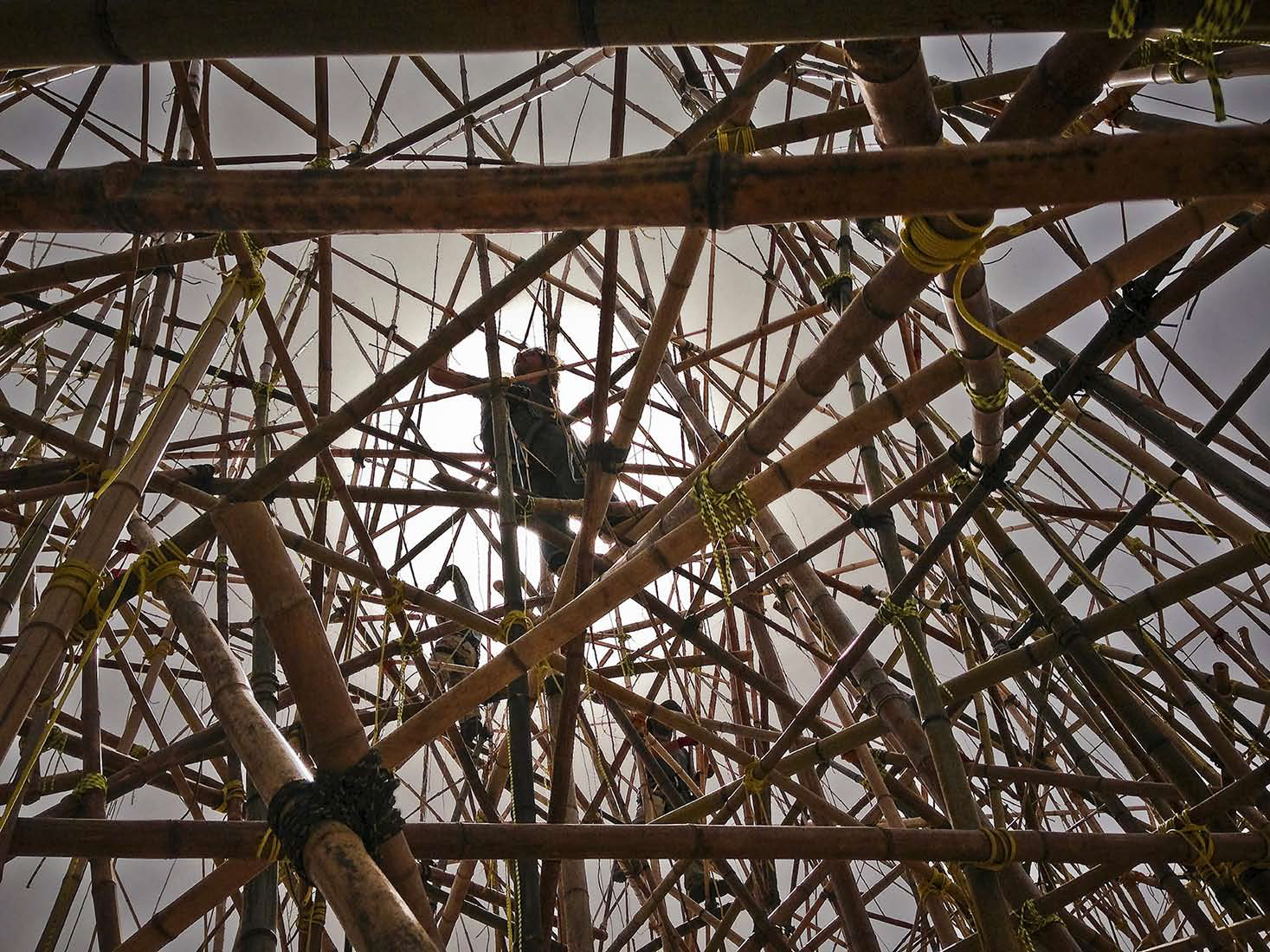INVISIBLE
ARCHITECTURE
Generate Your Own Sculpture
Doug and Mike Starn
Doug and Mike Starn (born 1961) are American artists, identical twins, and artist duo. Their work is known to transgress traditional categorisation, combining separate disciplines such as sculpture, photography, architecture, painting, video and installation.
The Starn's work explores themes of interconnection and interdependence.
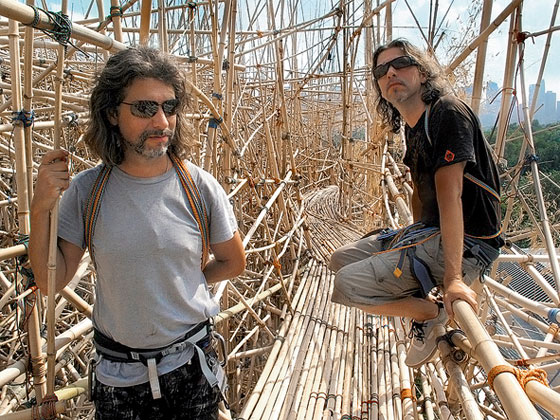
2008
Doug + Mike Starn Studio, Beacon
In September 2008, the Starns took over the former Tallix Foundry in Beacon, New York (50 foot high ceilings by 320-foot long by 65 foot wide), and the construction of Big Bambú immediately started.
This artwork, in the realm of architecture and performance, starts as a massive tower created from lashed together bamboo poles and brings into space representations of complexity and chaos. At its pinnacle, the continually evolving architecture being built from within (no outside scaffolding or support) will cantilever out as far as the bamboo poles network allows, and then will bridge down to the floor. At this point the first tower will be dismantled pole by pole and carried through the structure and down to create another monumental tower and then on again, walking down the 320 feet space, almost like a Slinky and then back again. Big Bambú will evolve through the continuous rebuilding and rethinking of the structure at all times.
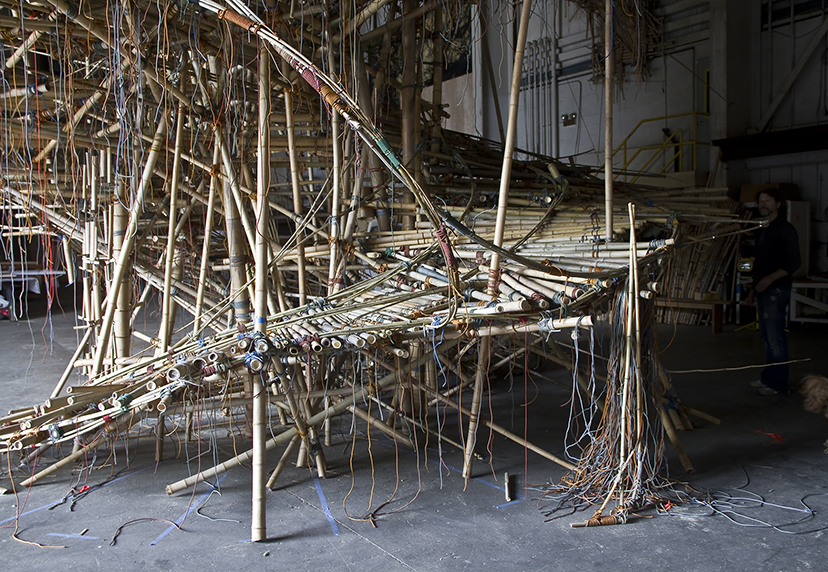
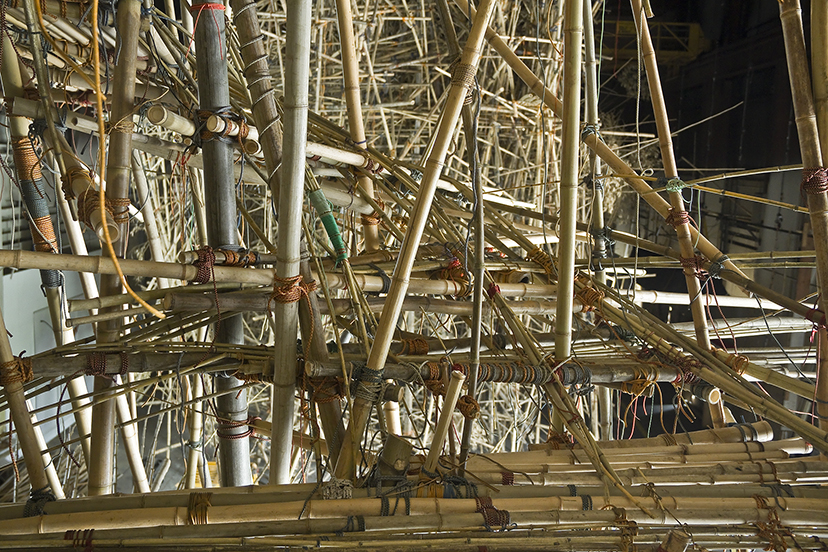
April 27—October 31, 2010
The Metropolian Museum of Art
American artists Mike and Doug Starn (born 1961) have been invited by The Metropolitan Museum of Art to create a site-specific installation for The Iris and B. Gerald Cantor Roof Garden, opening to the public on April 27. The identical twin brothers will present their new work, Big Bambú: You Can’t, You Don’t, and You Won’t Stop, a monumental bamboo structure ultimately measuring 100 feet long by 50 feet wide by 50 feet high in the form of a cresting wave that will bridge realms of sculpture, architecture, and performance. Visitors are meant to witness the creation and evolving incarnations of Big Bambú as it is constructed throughout the spring, summer, and fall by the artists and a team of rock climbers. Set against Central Park and its urban backdrop, the installation Doug + Mike Starn on the Roof: Big Bambú will suggest the complexity and energy of an ever-changing living organism.
It will comprise the 13th consecutive single-artist installation for the Cantor Roof Garden. The exhibition is made possible by Bloomberg. Additional support is provided by Cynthia Hazen Polsky and Leon B. Polsky. The exhibition is also made possible in part by the Jane and Robert Carroll Fund. Rope provided by Mammut Sports Group, Inc.
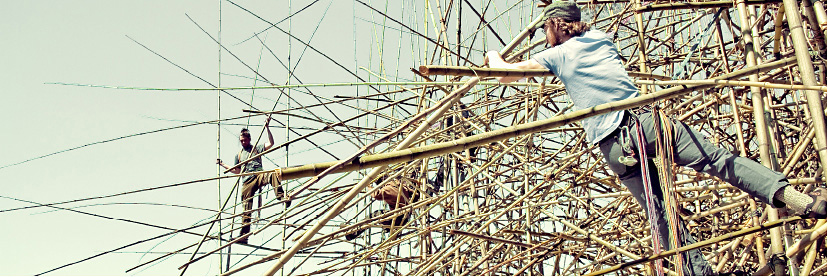
April 27—October 31, 2011
54th Venice Biennial
The central aspect of the ongoing sculpture in Venice is a 50' tall hollow tower of bamboo, with a trail spiraling up to the top reaching a 20' wide roof top lounge/Altana (there will be limited access). The Starns and their crew of rock climbers will continue to lash together bamboo, sustaining the spiral upward until the closing day of the sculpture, June 15th.
As Big Bambú is about the continual evolution of living things, in addition to 2,000 fresh poles harvested from a farm in France, Doug and Mike have cut several of the Fragments out of the Metropolitan installation. The Starns: "We are grafting a new Big Bambú and using 1,000 poles from the Met as stem cells, the Venice piece will still be the Metropolitan piece but also a new one, Big Bambú is always growing and changing and becoming something new-- as we all are." The Starns' Venice location is the former United States Consulate and is next door to the Peggy Guggenheim Collection on the Grand Canal. This is the first time it has been used as a location for a collateral exhibition since the famous triumph of American art in 1964 as the Annex to the American Pavilion when Robert Rauschenberg won the Grand Prize. It is currently the home of the Venice campus of Wake Forest University.
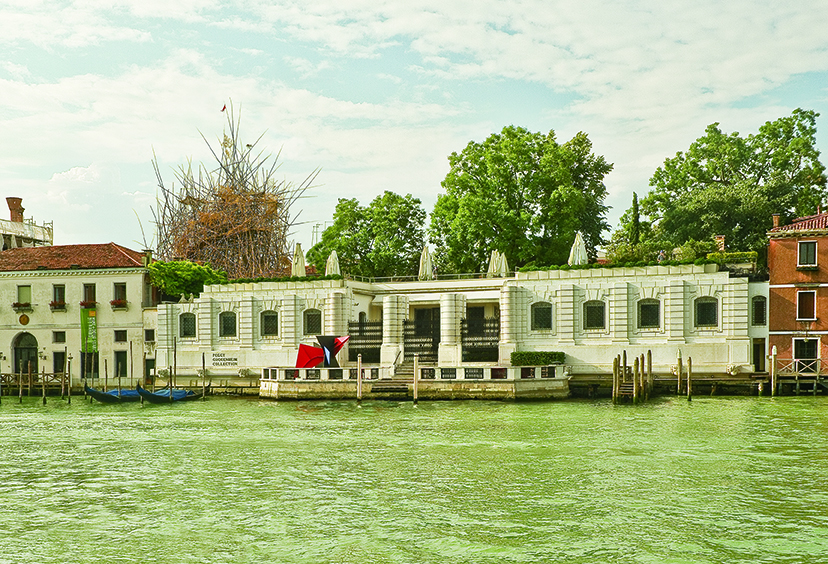

2012
Macro Testaccio Museum
Reaching over 130’ high (40 meters) clearly visible at great distances in the Trastevere/Testaccio districts of Rome, in the collection of the Macro Museum, Big Bambu became a symbol of the burgeoning arts neighborhood and of the museum located within the former stockyards of Rome. Situated within the sculpture at 20 feet high and created of the complex network of bamboo is a small performance space with seating for an audience of 40 surrounding and above the stage -like perches in a tree; as Macro Museum’s director Bartolomeo Pietromarchi described “an elevated public square” in which lectures, performances and video projections take place. An additional 20 visitors at a time can experience the double helix stair and labyrinth paths up to over 60' high to multiple habitable spaces giving a 360 degree perspective view. The sculpture is a vast network of 6,000 interconnected bamboo poles, lashed together with 60 miles of rock climber’s rope and took 10 weeks to build by the Starns and their crew comprised of 15 US based and 10 Italian rock climbers. It opened December 10th 2012.
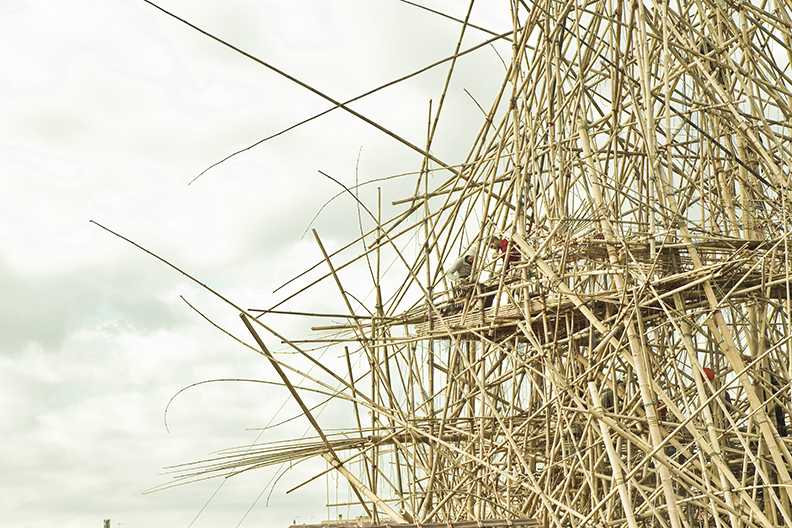
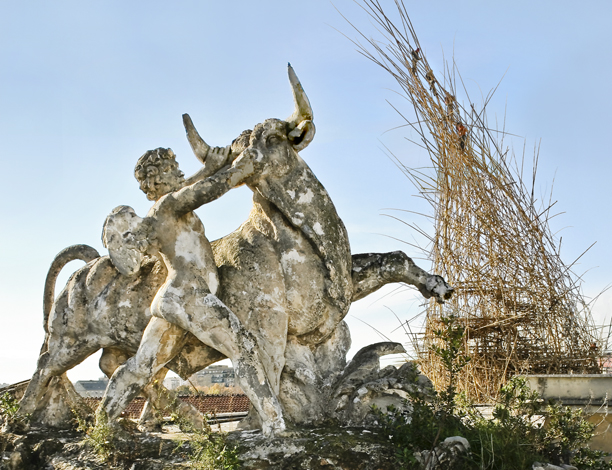
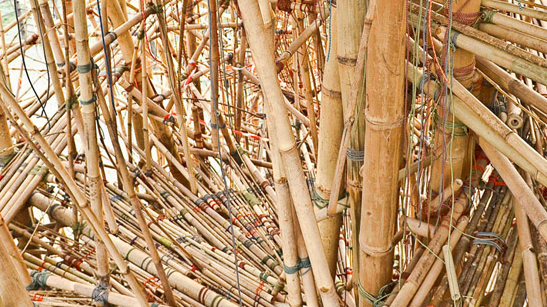
2013
Naoshima Museum, Setouchi Triennial
A beautiful path through the bamboo forest leads to a Bambú walkway tied directly to the living stalks and winds its way 200 feet up through the forest, higher and higher, until ultimately breaking through the surface of the canopy of bamboo leaves. A large fishing boat, 70 feet long and made entirely of Bambú, floats on the canopy sea of bamboo over 60 feet high. The visitor approaches the boat on the elevated path as if swimming through the canopy and climbs aboard. The view out from the boat shows the waves of bamboo leaves flowing in the breeze with the inland Seto Sea and a neighboring island in the distance. Bamboo leaves break over the bow and bamboo flows across the deck, tips of the long poles that are the fabric of the boat are splashes and fishing poles.Entering the cabin of the boat, the visitor descends below deck into the hull to see the chaotic interdependent structure creating the being of the boat interconnected with the sea. A catwalk through the hull leads the visitor to the bow andthe observation bubble which was thought up in a dream actually. The artwork encompasses the entire forest, The structure is created from several hundred living poles in the rhizomatic root system (new poles sprout daily, encroaching the elevated pathway) and about 2,000 poles harvested from other forests on the island and from Kyushu.
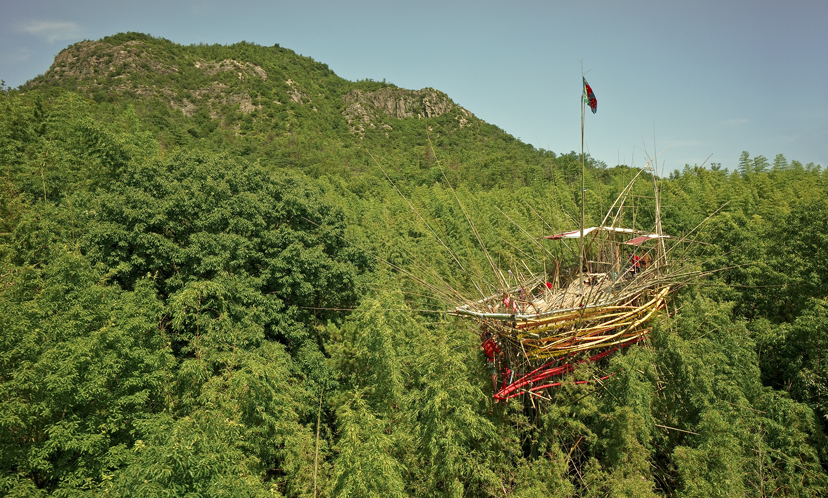
2015
The Israel Museum Jerusalem
Jerusalem, Israel (June 8, 2014)—This summer, artists Doug and Mike Starn transform the landscape of the Israel Museum’s Billy Rose Art Garden with a monumental installation of bamboo and rope, towering 16 meters (52.5 feet) high and covering an area of more than 700 square meters (7,500 square feet). Opening to the public officially on June 16, visitors have been able to watch this immersive environment taking shape in the Garden since the end of April, as the Starn brothers and their team of rock climbers worked to construct the site-responsive installation and collaborate in the performative act of its creation. Composed of more than 10,000 bamboo poles, 5,000 Arms to Hold You, is being activated throughout the summer as visitors are invited to experience the work from within and without, ascending to its uppermost peaks and participating in cultural programming inspired by and performed within and around it. On view in its entirety through October 2014, the tower element that comprises the highest point of 5,000 Arms to Hold You will remain as a permanent sculptural installation in the Museum’s Garden.
